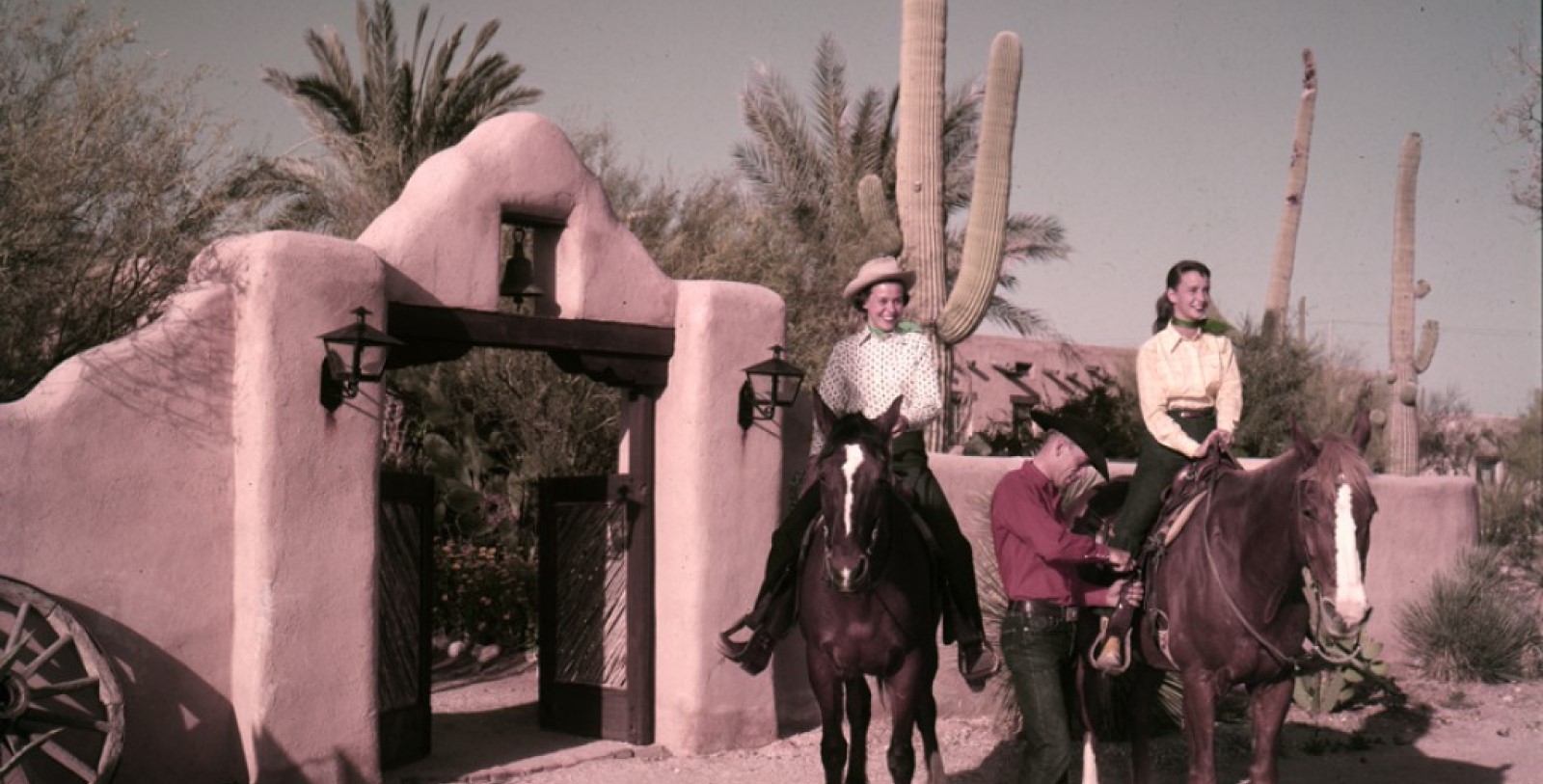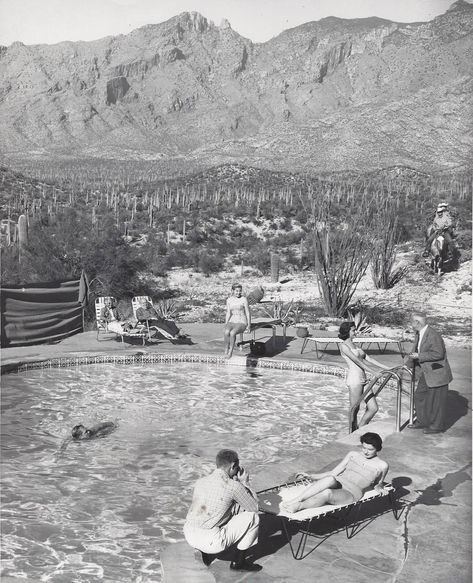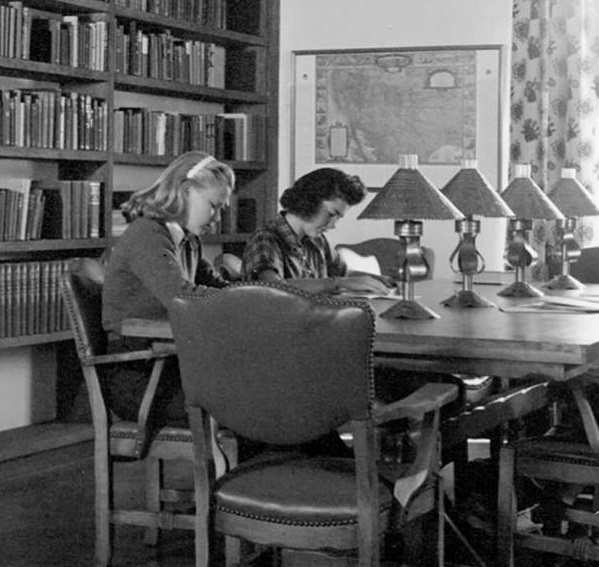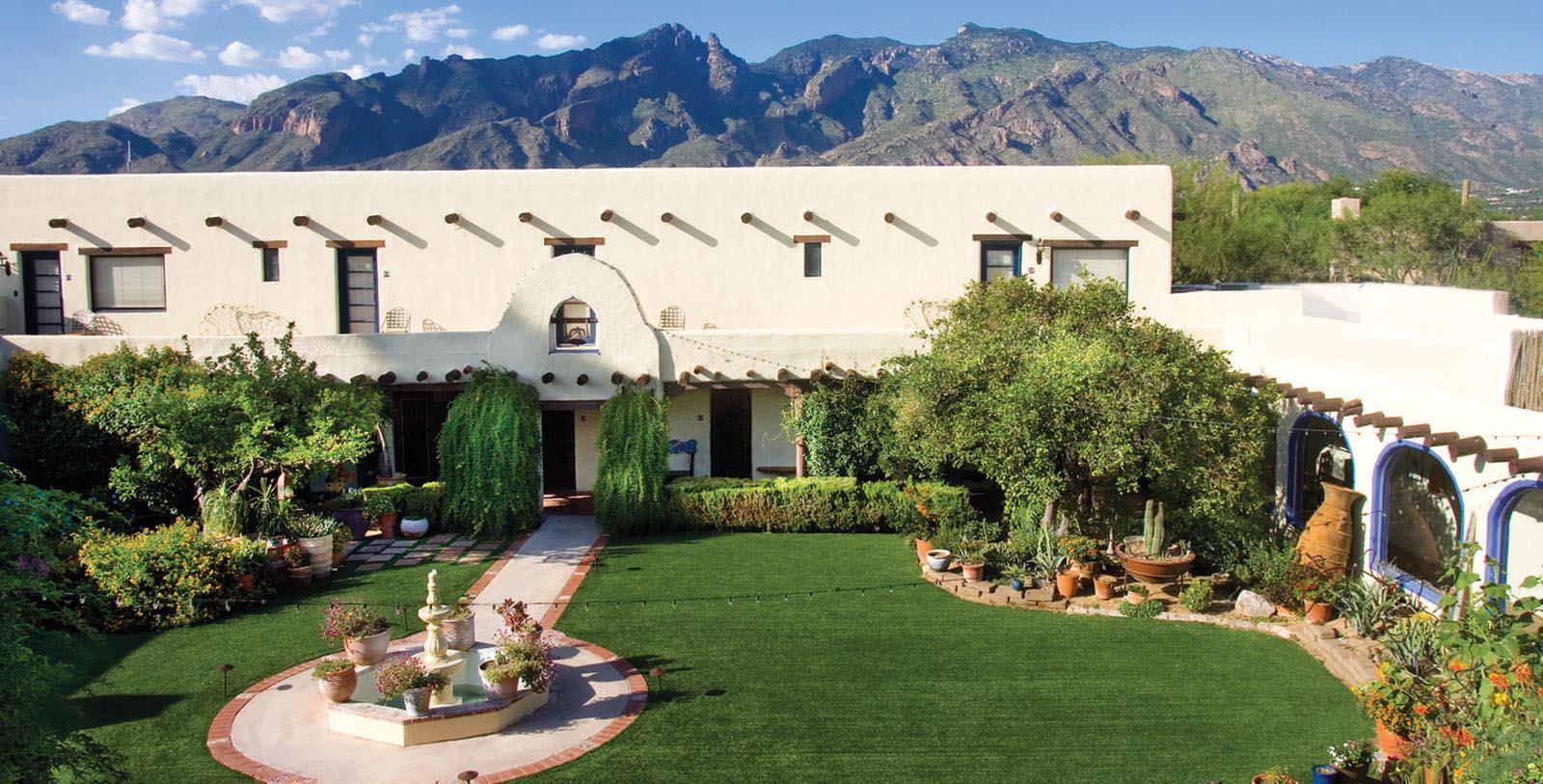Receive for Free - Discover & Explore eNewsletter monthly with advance notice of special offers, packages, and insider savings from 10% - 30% off Best Available Rates at selected hotels.
history
Discover Hacienda Del Sol Guest Ranch Resort, which was a ranch school for girls from elite families, including Vanderbilt and Westinghouse.
Hacienda Del Sol Guest Ranch Resort, a member of Historic Hotels of America since 2009, dates back to 1929.
VIEW TIMELINEA member of Historic Hotels of America since 2009, the Hacienda Del Sol Guest Ranch Resort is one of Tucson’s most celebrated holiday destinations. It possesses brilliant, unobstructed views of the picturesque Santa Catalina mountains that surround the city. Yet, this magnificent place has not always operated as a luxurious resort. Its history actually began in 1929, when Helen and John Murphey founded a youth boarding academy on the grounds. Called the “Hacienda Del Sol School,” the facility was a “girls only” educational institution that taught adolescent women for years. Hacienda del Sol offered a college preparatory curriculum and a true taste of western outdoor activities. The extracurricular events specifically focused on equine sports, with the school even allowing space for the students to house the horses. Some of the most prominent families in the country sent their children to the Murpheys’ school, including the likes of the Vanderbilts, the Westinghouses, the Spaldings, the Pillsburys, and the Kelloggs. Even a granddaughter of former U.S. President Woodrow Wilson attended the school for a time. But both the students and the Murpheys looked upon the Hacienda Del Sol as their home. Helen and John took special care of the place, going as far as to directly construct portions of the facility themselves. Helen even carved intricate patterns into the beamed ceilings of the main building’s library! Truly, the Hacienda Del Sol was a relaxing retreat as much as it was a rigorous school.
The Hacienda Del Sol School encountered its fair share of adversities, though. For instance, the Murpheys were forced to initiate an extensive renovation in the 1930s, hiring Josias Joesler to reconstruct the entire complex. America’s entry into World War II caused even more hardships, as the Hacienda Del Sol School had to shutter its doors for the duration of the conflict. Educational activities only resumed once Germany and Japan surrendered to Allied forces in the fall of 1945. Nevertheless, the Murphey’s still struggled to restart their school once the fighting had ended. As such, they made the decision to sell their beloved facility to the family of Howard Morgan for a sum of $110,000. But the Morgans would prove to be wonderful stewards, spending thousands on refurbishing the remarkable facility. They did not reopen the site as a school, however, instead transforming it into a luxurious dude ranch resort known as the “Hacienda Del Sol Hotel.” Architect Lewis Hall—a protégé of Joesler’s—presided over the renovations, brilliantly reviving the Spanish Colonial Revival-style architecture that the Murpheys first developed two decades prior. Debuting before a sold-out crowd in 1948, the new resort quickly became one of the most luxurious vacation hotspots in the southwestern United States. It soon attracted the likes of Clark Gable, John Wayne, and Katherine Hepburn. Even the legendary aviator Howard Hughes stayed for long periods of time, as his company—the Hughes Aircraft Company—had moved to downtown Tucson in 1951.
The prosperity was not destined to last forever, as the resort fell into hard times in the 1970s and 1980s. It exchanged hands several times, even going into receivership for several years starting in 1983. Fortunately, salvation arrived once more in the form of a few local investors led by Jeffery B. Timan and Richard Find. They purchased the destination for a sum of $1 million in 1995 and immediately began an extensive restoration of the whole complex. The group spared no expense in restoring the facility back to its former glory. When the work finally concluded, the location reopened as the marvelous “Hacienda Del Sol Guest Ranch Resort.” The new owners only continued to expand the lavish appeal of the Hacienda Del Sol Guest Ranch, adding such amazing facilities like fine dining restaurant known as “The Grill.” Further additions emerged in 2015, too, with the debut of a new spa complex, a large outdoor swimming pool, and a terrific meeting venue called “Casa Luna.” Since its return, Hacienda Del Sol has received numerous awards and accolades for its spectacular service. The resort has earned recognition as a top holiday destination from the likes of National Geographic Traveler, and Travel & Leisure Magazine. The Grill itself has been a magnate for praise, winning honors from Wine Spectator, the Tucson Lifestyle Magazine, and the Culinary Gold Awards. As such, Hacienda Del Sol Guest Ranch Resort is one of the best places to visit in all of Arizona. An important part of Tucson’s colorful heritage, this wonderful historic destination is a fantastic place to start exploring the beauty of the American southwest.
-
About the Location +
People have lived in the area of Tucson for the better part of four millennia, making one of the most historically occupied regions in the United States. Archeologists today believe that Paleo-Indians were among the first to settle the land, with the earliest village appearing in 2100 BC. Permanently settled horticulture followed suit, as current evidence suggests that widespread farming was commonplace by 1200 BC. The farming became increasingly more intricate, with a vast canal system appearing to irrigate the various fields. Spanish missionaries led by Eusebio Francisco Kino encountered this prolific society when they arrived in the area during the late 1690s. They founded the Mission San Xavier de Bac several miles upstream from modern Tucson, the missionaries had come to spread Christianity on behalf of the Spanish Crown. The Spanish colonial settlements remained rather disparate until Hugo Oconór commissioned the construction of a military fort called the “Presidio San Agustín del Tucsón” in 1775. Constructed upon what is now the Pima County Courthouse, the citadel protected the nascent villages in the area from raids by mounted Apache warriors. Peace eventually fell upon the area, with a small town forming around the base of the fort. Its inhabitants took to calling it simply as “Tucsón” after a native word used to describe the area.
Tucsón remained an outpost for settlers venturing north into the frontier after the settlement became a part of Mexico in 1821. But during the Mexican-American War of 1846 to 1848, the town was briefly under American control when General Philip St. George Cooke captured Tucsón with a battalion of Mormon volunteers. Nevertheless, Cooke returned the settlement over to Mexican authority toward the end of the conflict, as he made his way west in the direction of California. He specifically constructed a famous wagon road that became one of the most important routes linking Tucsón to the Pacific Coast. Thousands of hopeful Americans flooded the route as they stampede west at the onset of the California Gold Rush. Yet, the town remained in Mexico for the next few years, despite the rest of Arizona falling under American jurisdiction. It was not until the U.S. ambassador to Mexico, James Gadsden, arranged to purchase all the land south of the Gila River that Tucsón formally became a part of the United States. Known as the “Gadsden Purchase,” the land sale sought to provide more room in which the build an American-run transcontinental railroad. Even though the transaction took place in 1854, the first American officials—and their military escorts—did not arrive until two years later. Soon enough, the new inhabitants were referring to the town as “Tuscon”—an anglicized version of its name. The military attache also established its own base known as Fort Lowell, which protected travelers as they made their way into the city.
Tucson’s proximity along the Cooke Wagon Trail caused its popularity to gradually grow to the point where Arizona’s territorial legislature incorporated it as a city in 1877. Yet, its relative remoteness on the American frontier made it the target of countless criminal acts by dangerous outlaws. Tucson quickly epitomized the caricature of the American “Wild West.” Some of the most common crimes involved stagecoach robberies, with the most notable involving the renegade William Whitney Brazelton. Brazelton had held up two stagecoaches a few miles outside of Tucson in the summer of 1878. Pima county Sherriff Charles A. Shibell had to organize an armed posse just to apprehend the violent criminal. A shootout eventually transpired south along the Santa Cruz River that saw Brazelton killed. More famous shootouts occurred in Tucson between law enforcement and roving bands of fugitives. Perhaps one of the greatest gun fights to occur within the city limits is known to history as the “Earp-Clanton Tragedy.” In 1882, Morgan Earp—brother of the legendary Deputy U.S. Marshal Wyatt Earp—was assassinated by the bandit Frank Stilwell and his gang. In vengeance, Wyatt Earp gathered his other brother Virgil Earp and a few friends to track down the rebellious Stilwell. In short order, they managed to find Stilwell lying in wait to kill Virgil at the steps of the Tucson railroad station. Surprising Stilwell, Wyatt Earp and his group killed the cowboy and most of his band before leaving the territory for California.
Tucson had cast aside its violent reputation toward the end of the 1800s, emerging as one of the most attractive places to live in the southeastern United States. The railroads greatly influenced the transformation, for they better connected the city with its surrounding communities. One of the greatest signs that the city was becoming pacified was the creation of the University of Arizona just outside of Fort Lowell. By 1900, the population of Tucson had increased to nearly 7,000 with some five percent immigrating from Asia. That number had practically doubled by the time Arizona officially joined the union in 1912. By the mid-20th century tens of thousands had relocated to the economically vibrant Tucson. For a time, Tucson was the even largest settlement in the state, surpassing Phoenix in its size until the 1920s. Nevertheless, the city continued to play an important role in Arizona’s history, acting as the commercial center for the southern part of the state. Driving much of this growth was Hughes Aircraft, which moved to Tucson in 1951. Employing some 14,000 residents, the company did much to diversify the local economy. Now known as Raytheon, the company still occupies the same facility it first inhabited several decades ago. It also hosted a massive military hospital for veterans sponsored by the U.S. Veterans Administration. In recent years, a prosperous optics industry has also appeared within the city that gave Tucson the nickname of “Optics Valley.” Today, the City of Tucson is one of the most culturally vivacious places in the entire country. It is filled with countless cultural attractions of world renown, such as the Reid Park Zoo, the Tucson Botanical Gardens, and the Pima Air & Space Museum. The historic Mission San Xavier del Bac is still located just outside of the city, which the U.S. Department of the Interior designated as a National Historic Landmark.
-
About the Architecture +
When Helen and John Murphey began constructing the school in 1929, they chose Spanish Colonial Revival-style architecture as the source of their inspiration. Also known as “Spanish Eclectic,” this architectural form is a representation of themes typically seen in early Spanish colonial settlements. Original Spanish colonial architecture borrowed its design principles from Moorish, Renaissance, and Byzantine forms, which made it incredibly decorative and ornate. The general layout of those structures called for a central courtyard, as well as thick stucco walls that could endure Latin America’s diverse climate. Among the most recognizable features within those colonial buildings involved heavy carved doors, spiraled columns, and gabled red-tile roofs. Architect Bertram Goodhue was the first to widely popularize Spanish Colonial architecture in the United States, spawning a movement to incorporate the style more broadly in American culture at the beginning of the 20th century. Goodhue received a platform for his designs at the Panama-California Exposition of 1915, in which Spanish Colonial architecture was exposed to a national audience for the first time. His push to preserve the form led to a revivalist movement that saw widespread use of Spanish Colonial architecture throughout the country, specifically in California and Florida. Spanish Colonial Revival-style architecture reached its zenith during the early 1930s, although a few American businesspeople—including Patrick J. Kennedy—continued to embrace the form well into the late 20th century.
-
Famous Historic Guests +
Clark Gable, actor known for his roles in It Happened One Night, Mutiny on the Bounty, Gone with the Wind.
John Wayne, actor known for his roles in The Man Who Shot Liberty Valance, True Grit, and The Longest Day.
Katharine Hepburn, actress known for her roles in The African Queen and Woman of the Year.
Spencer Tracy, actor known for such role sin Adam’s Rib, Woman of the Year, and Guess Who’s Coming to Dinner.
Lee Marvin, actor known for such roles in The Dirty Dozen, Point Blank, and Cat Ballou.
Gregory Peck, actor known for such roles in Twelve O’Clock High, Gentleman’s Agreement, and To Kill a Mockingbird.
Jennifer Jones, actress known for such roles in The Song of Bernadette and Love is a Many-Splendored Thing.
Joseph Cotton, actor known for such roles in Shadow of a Doubt, The Third Man, and The Magnificent Ambersons.
Waylon Jennings, country musician best remembered for his role as part of the Outlaw Movement.
Tris Speaker, Hall of Fame outfielder for the Cleveland Indians remembered today as “The Gray Eagle.”
Hank Greenberg, Hall of Fame first basemen for the Detroit Tigers remembered today as “Hammerin’ Hank.”
Sam Snead, winner of 7 major golf championships that include the PGA of America and Senior PGA Tour.
Howard Hughes, business magnate and pilot best known for creating the Hughes Aircraft Company in 1932.
-
Film, TV and Media Connections +
Duel in the Sun (1946)







































